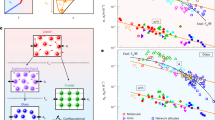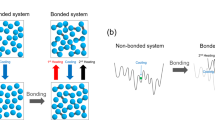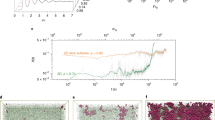Abstract
Glass formation is usually viewed in terms of physical vitrification: a liquid in a metastable state1 is cooled or compressed so as to avoid crystallization. However, glasses may also be formed by chemical vitrification, a process involving progressive polymerization of the constituent molecules via the formation of irreversible chemical bonds. The formation of most of the materials used in engineering plastics and the hardening of natural and synthetic resins are based on chemical vitrification. Despite the differences in the molecular processes involved in chemical and physical vitrification, surprising similarities2,3,4,5,6,7,8,9 are observed in the slowing down of the dynamics and in the thermodynamical properties of the resulting glasses. Explaining such similarities would improve general understanding of the glass transition and may disclose its universal nature. Here we report dielectric and photon-correlation measurements that reveal the origin of the similarity in the dynamical behaviour of physical and chemical glass formers. We find that the evolution of their configurational restrictions proceeds in a similar manner. In particular, we make a connection between the reduction in configurational entropy and the number of chemical bonds, a quantity that can be controlled in experiments.
This is a preview of subscription content, access via your institution
Access options
Subscribe to this journal
Receive 51 print issues and online access
$199.00 per year
only $3.90 per issue
Buy this article
- Purchase on Springer Link
- Instant access to full article PDF
Prices may be subject to local taxes which are calculated during checkout

Similar content being viewed by others
References
Debenedetti, P. G. Metastable Liquids. Concepts and Principles (Princeton Univ. Press, Princeton, 1996)
Deng, Y. & Martin, C. Analysis of the cure-dependent dielectric relaxation behavior of an epoxy resin. J. Polym. Sci. B 32, 2115–2125 (1994)
Cassettari, M., Salvetti, G., Tombari, E., Veronesi, S. & Johari, G. P. Dielectrics and thermodynamics of a macromolecule's growth. J. Non-Cryst. Solids 172–174, 554–561 (1994)
Casalini, R., Corezzi, S., Fioretto, D., Livi, A. & Rolla, P. A. Unified dielectric description of the dynamics of polymeric systems undergoing either thermal or chemical vitrification. Chem. Phys. Lett. 258, 470–476 (1996)
Tombari, E., Ferrari, C., Salvetti, G. & Johari, G. P. Molecular dynamics during linear chain polymerization from real-time dielectric spectrometry and calorimetry. J. Phys. Condens. Matter 9, 7017–7037 (1997)
Johari, G. P., Ferrari, C., Tombari, E. & Salvetti, G. Temperature modulation effects on a material's properties: Thermodynamics and dielectric relaxation during polymerization. J. Chem. Phys. 110, 11592–11598 (1999)
Gallone, G., Capaccioli, S., Levita, G., Rolla, P. A. & Corezzi, S. Dielectric analysis of the linear polymerization of an epoxy resin. Polym. Int. 50, 545–551 (2001)
Parthun, M. G. & Johari, G. P. Dielectric spectroscopy of a polymerizing liquid and the evolution of molecular dynamics with increase in the number of covalent bonds. J. Chem. Phys. 103, 440–450 (1995)
Johari, G. P., Ferrari, C., Salvetti, G. & Tombari, E. Physico-chemical aspects of dielectric and thermodynamic changes during high-temperature polymerization and their technical use. Phys. Chem. Chem. Phys. 1, 2997–3005 (1999)
Adam, G. & Gibbs, J. H. On the temperature dependence of cooperative relaxation properties in glass-forming liquids. J. Chem. Phys. 43, 139–146 (1965)
Xia, X. & Wolynes, P. G. Fragilities of liquids predicted from the random first order transition theory of glasses. Proc. Natl Acad. Sci. USA 97, 2990–2994 (2000)
Richert, R. & Angell, C. A. Dynamics of glassforming liquids. V: On the link between molecular dynamics and configurational entropy. J. Chem. Phys. 108, 9016–9026 (1998)
Casalini, R., Capaccioli, S., Lucchesi, M., Rolla, P. A. & Corezzi, S. Pressure dependence of structural relaxation time in terms of the Adam-Gibbs model. Phys. Rev. E 63, 031207 (2001)
Casalini, R. et al. Effect of pressure on the dynamics of glass formers. Phys. Rev. E 64, 041504 (2001)
Scala, A., Starr, F. W., La Nave, E., Sciortino, F. & Stanley, H. E. Configurational entropy and diffusivity of supercooled water. Nature 406, 166–169 (2000)
Sastry, S. The relationship between fragility, configurational entropy and the potential energy landscape of glass-forming liquids. Nature 409, 164–167 (2001)
Matsuoka, S., Quan, X., Bair, H. E. & Boyle, D. J. A model for the curing reaction of epoxy resins. Macromolecules 22, 4093–4098 (1989)
Young, R. J. & Lovell, P. A. Introduction to Polymers (Chapman and Hall, New York, 1991)
Macosko, C. W. & Miller, D. R. A new derivation of average molecular weights of nonlinear polymers. Macromolecules 9, 199–206 (1976)
Kauzmann, W. The nature of the glassy state and the behavior of liquids at low temperatures. Chem. Rev. 43, 219–256 (1948)
Vogel, H. Temperature dependence of viscosity of melts. Phys. Z. 22, 645–646 (1921)
Angell, C. A. Relaxation in liquids, polymers and plastic crystals—strong/fragile patterns and problems. J. Non-Cryst. Solids 131–133, 13–31 (1991)
Stillinger, F. H. A topographic view of supercooled liquids and glass formation. Science 267, 1935–1939 (1995)
Sastry, S., Debenedetti, P. G. & Stillinger, F. H. Signatures of distinct dynamical regimes in the energy landscape of a glass-forming liquid. Nature 393, 554–557 (1998)
Debenedetti, P. G. & Stillinger, F. H. Supercooled liquids and the glass transition. Nature 410, 259–267 (2001)
La Nave, E., Mossa, S. & Sciortino, F. Potential energy landscape equation of state. Phys. Rev. Lett. 88, 225701 (2002)
Kumar, S. K. & Douglas, J. F. Gelation in physically associating polymer solutions. Phys. Rev. Lett. 87, 188301 (2001)
Martinez, L.-M. & Angell, C. A. A thermodynamic connection to the fragility of glass-forming liquids. Nature 410, 663–667 (2001)
Lun˘ák, S. & Dus̆ek, K. Curing of epoxy resins. II. Curing of bisphenol A diglycidyl ether with diamines. J. Polym. Sci. Polym. Symp. Edn 53, 45–55 (1975)
Acknowledgements
We thank G. Gallone and S. Capaccioli for providing dielectric measurements on EPON828/EDA 1:1 and EPON828/BAM 1:1 systems, and L. Comez, P. Grigolini, S. Mossa, G. Ruocco, A. Scala and G. Socino for comments on the manuscript. We particularly thank F. Sciortino for assistance.
Author information
Authors and Affiliations
Corresponding author
Ethics declarations
Competing interests
The authors declare that they have no competing financial interests.
Rights and permissions
About this article
Cite this article
Corezzi, S., Fioretto, D. & Rolla, P. Bond-controlled configurational entropy reduction in chemical vitrification. Nature 420, 653–656 (2002). https://doi.org/10.1038/nature01261
Received:
Accepted:
Issue Date:
DOI: https://doi.org/10.1038/nature01261
This article is cited by
-
Creating bulk ultrastable glasses by random particle bonding
Nature Communications (2023)
-
Exploiting limited valence patchy particles to understand autocatalytic kinetics
Nature Communications (2018)
-
Molecular dynamics simulation of the glass transition temperature of fullerene filled cis-1,4-polybutadiene nanocomposites
Chinese Journal of Polymer Science (2018)
-
Supercooled liquids with enhanced orientational order
Nature Communications (2012)
Comments
By submitting a comment you agree to abide by our Terms and Community Guidelines. If you find something abusive or that does not comply with our terms or guidelines please flag it as inappropriate.



